Review of A Diver’s Guide to Underwater Malaysia Macrolife
Bad marine field guides should be stored in deep, dark recesses on dank, dingy dive boats. Good guides should be perused by congenitally disliked divers bent on “impressing” the rest of us with their mind-numbing array of knowledge. Of course, the very best field guides belong on shelves and are only to have the dust blown off them when we want to identify a bizarre fish before uploading the image to Wetpixel’s Photo of the Week contest.
I’m sure lots of divers feel this way about field guides. But this attitude is wrong, wrong, wrong. Field guides are not just for identifying mysterious fish. Nor should the socially inept use them as instruments to further distance people from the majesty of the ocean. Hogwash! As underwater photographers, we should consider field guides a necessary part of pre-departure planning, as essential as hotel reservations, and devoured eagerly before leaving the dock.
Recently, I got a copy of Andrea and Antonella Ferrari’s A Diver’s Guide to Underwater Malaysia Macrolife. The excellent 468-page book spotlights 600 different Indo-Pacific marine species and clearly and elegantly describes their distribution, size, and habits. Moreover, many of the 800 color images in the book feature tips for how you can shoot these creatures for your own photo album. Though the title refers to Malaysia, in reality, the guide is useful for divers exploring that enormous swath of blue undulating from the Maldives to Australia. If you’re planning a trip to this region, A Diver’s Guide is among the most important things to pack. But pack it last – so you can grab it quickly.
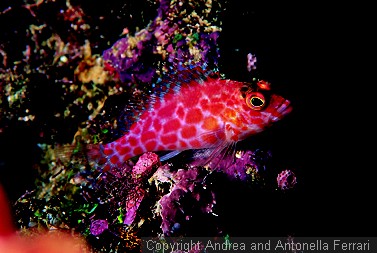
At the heart of the Indo-Pacific is the so-called Coral Triangle. This area – generally covering Malaysia, the Philippines, and Papua New Guinea – thumps with the greatest concentration of marine biodiversity on the planet. As word has spread about the area’s Popeye-healthy reefs and absurdly abundant marine life, the Triangle has quickly shot to the top of most divers’ Must Dive Lists. Moreover, as attitudes have changed about what makes a “good dive” (shifting gradually from oceanic diving in hunt of large, easy-to-spot pelagics, to shallower-water diving in search of tiny, colorful creatures), this area is becoming even more enthralling for divers. Of course, since many divers are not native to the area, learning about its residents is critical to making the most out of a potentially costly and lengthy trip. A Diver’s Guide is an essential overview of the entire region. If, for some reason, you’ve never considered this area for an upcoming trip, reading the Ferraris’ short but persuasive Introduction will almost certainly sway you – if looking at the images within the book does not.
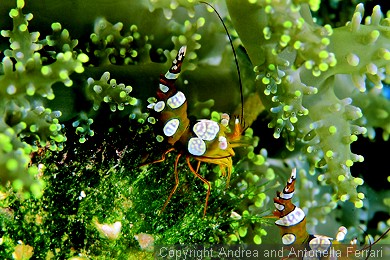
And let’s talk about those images. When looking through A Diver’s Guide, you can’t help but notice all the crisp, bright images. Though some of the pictures are only a few inches wide, it’s worth noting that many of the critters featured in the book max out at 2 centimeters, meaning the images are life-sized – or even larger than life! Further, some of the “big animals” – measuring a whopping 30 centimeters! – get stunning, richly-colored, full page spreads.
Though the Ferraris demur, in their introduction, that the photos in the book are “documentary-style, clear profile images” rather than “artful effect shots,” the book’s shots are indeed striking. In fact, as I was looking through the book on a plane, the ‘Nosey Rosey’ seated next to me interrupted me, saying, “Sorry, I couldn’t help but notice how beautiful the pictures in that book are.” In fact, the book is chock full of jaw-dropping shots – from near-transparent and unidentified cuttlefish; to an amazing gallery of the Wonder octopus; to a rare image of a female Peacock mantis shrimp, protectively clutching her brood of fertilized eggs! Documentary-style… as if! Most underwater photographers would give their left strobe for some of the shots in this book!
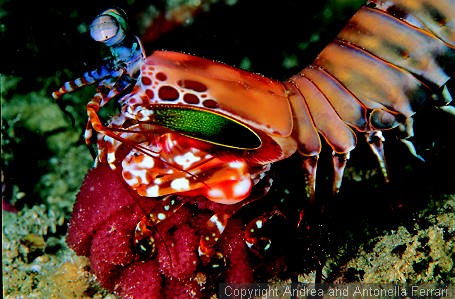
Divided into two broad sections – invertebrates and fishes – and subdivided into families, each of the subjects in the book is given a handsome head shot and some descriptive information about its size, distribution, habitat and how it may most easily be photographed. As an example, let me point you to the 1.4-centimeter-long Hairy squat lobster, profiled on page 181, which is only found inside large sponges, especially those belonging to the genus Xestospongia. The Ferraris advise: “Do not underestimate its drab coloring underwater! Not always easy to find and frame correctly, however, due to its very small size and cryptic habits: a normal 105mm macro lens will barely be enough to get a good enlargement. Use of a screw-on macro lens is advised.” Wow. It’s like having a dive guide and a photo pro right next to you. All you need to do now is trip the shutter, print the shot, and hang it on the wall.
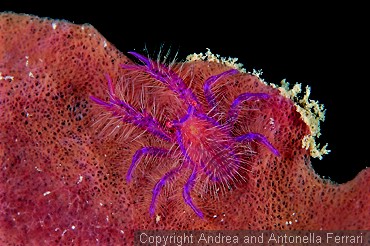
By spending time digesting A Diver’s Guide, you can discover practical tips about the etology of many species, making it far more likely that you’ll actually encounter (and successfully shoot) a particular creature. In truth, spending time with A Diver’s Guide is no different than checking your camera’s settings before a dive. Doing both makes that much more prepared when you hit the water.
After using A Diver’s Guide, divers will no longer consider all field guides simply “after-the-fact resources” to check, time permitting, between dives or after the trip has ended. Rather, divers will likely find themselves consulting its pages before a trip to acquaint themselves with what they’re likely to see and where they’re most likely to see it. Moreover, they’ll check the guide regularly during a trip to help them plan their dives, and decide before they even get their fins wet where they want to swim for their next cover shot. Considering the details the Ferraris provide about where to find the animals and how best to shoot them, the idea of securing a cover shot isn’t that crazy-sounding.
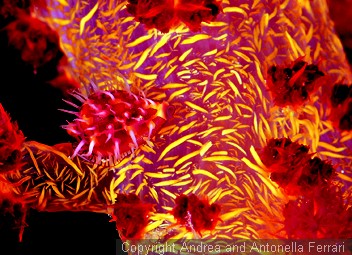
If you’re going to the time and trouble of slogging all the way to the Indo-Pacific to thrill in the world’s most beautiful, vibrant, and pristine dive spots, grab a copy of A Diver’s Guide to Underwater Malaysia Macrolife. The book is available in hardcover from both Amazon UK (for £30.00) and Sea Challengers (for $45). Don’t think of it as an extra thing to pack. Rather, think of it as an essential piece of equipment to take with you. As vital as a BC, A Diver’s Guide will help you get the most out of your trip.
If you’re interested, Wetpixel has also posted reviews of two other books by the Ferraris: A Diver’s Guide to Reef Life and Ocean Secretos.
-Willy Volk